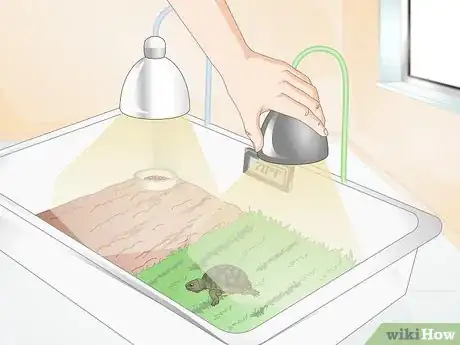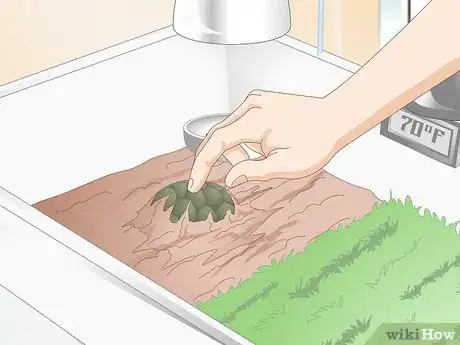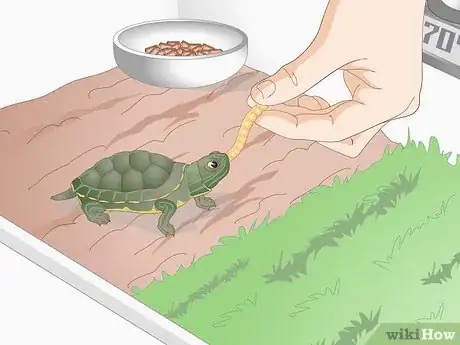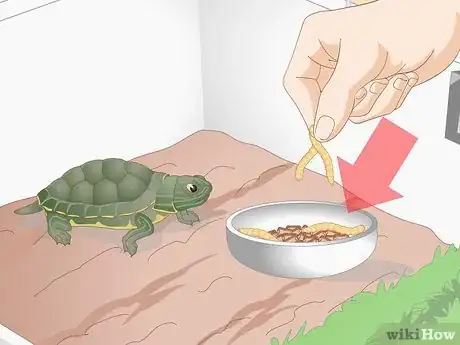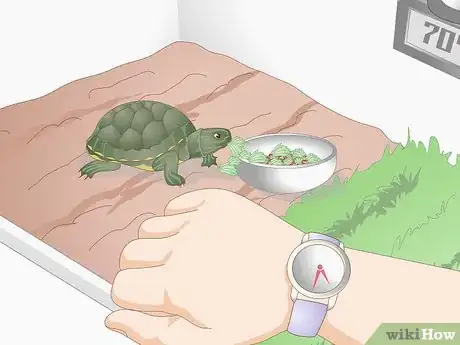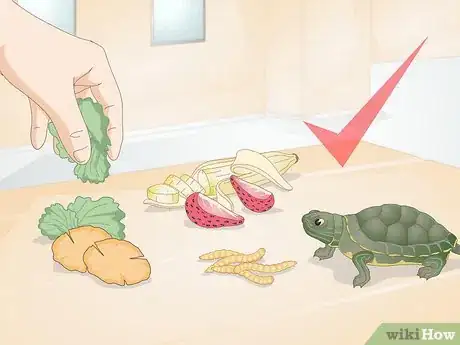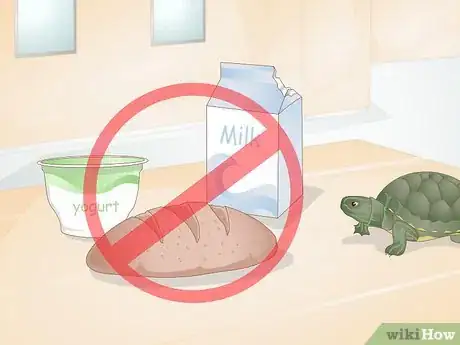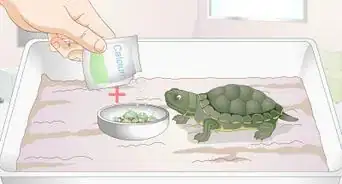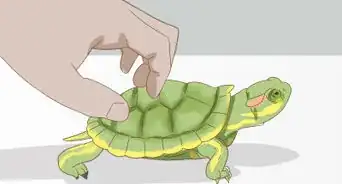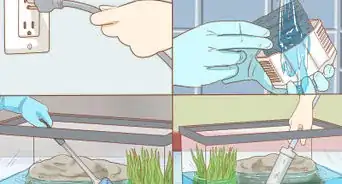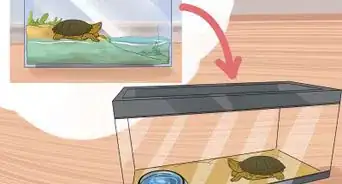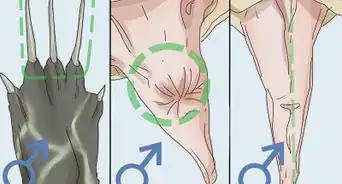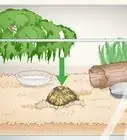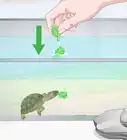This article was co-authored by Audra Barrios. Audra Barrios is a Marine Biologist and owner of Lick Your Eyeballs, a business offering experiemces, reptiles, supplies and plants. With over 15 years of experience, Audra specializes in reptiles and exotic animals, environmental education, marine biology, conservation issues, and animal husbandry. Audra earned a BASc in Marine Biology from the University of California, Santa Cruz, and studied Natural Sciences at the College of Marin. She is the founder and Executive Director of Things That Creep, a non-profit dedicated to herptile conservation through education. She has spent the last nine years working as a biologist at the California Academy of Sciences.
There are 18 references cited in this article, which can be found at the bottom of the page.
wikiHow marks an article as reader-approved once it receives enough positive feedback. This article received 14 testimonials and 86% of readers who voted found it helpful, earning it our reader-approved status.
This article has been viewed 375,563 times.
Concern may arise if you see that your turtle is refusing to eat. Not only does it increase the possibility of starving, but it also could have fallen ill. This article will show you how to get your turtle to eat and what to do if it still refuses to chew. Many turtle owners have trouble getting their pets to eat. Your turtle is most likely not eating due to environmental issues. However, your turtle may also be suffering from some sort of illness. By adjusting your turtle's environment, recognizing signs of illness, and being creative during feedings, you can get your turtle to eat.
Steps
Determining Why Your Turtle Won't Eat
-
1Check the temperature. Turtles are cold blooded reptiles and will not eat if the temperature is too cold.[1] If you have an indoor box turtle, provide a warm area and a cool area. The cool area should be between 68 and 72 degrees Fahrenheit and the warm area should be 85 degrees Fahrenheit during the day. At night, the temperature can drop to between 60 and 75 degrees Fahrenheit.[2]
- For aquatic turtles, the water temperature should be about 78 degrees Fahrenheit. The basking area should be between 80 and 85 degrees Fahrenheit.
- If your box turtle lives outside, the turtle will become too cold if the outside temperature drops below 60 degrees Fahrenheit. You may need to add a ceramic heater to your turtle's environment to get it to reach an adequate temperature.
- Check the temperature of your turtle environment using a thermometer and make adjustments if necessary.
-
2Provide more light. Your turtle also needs adequate light to have a healthy appetite. Aquatic turtles need both UVA and UVB light in their tank. Provide your turtle with 12 to 14 hours of light followed by 10 to 12 hours of darkness.[3] Box turtles need light for at least 12 hours every day. This can be direct sunlight or a combination of a UVB bulb and an incandescent bulb.[4]
- If your turtle is getting less than 12 hours of a light a day, it will probably stop eating.
- If you have an outside box turtle, you will need to adjust the light source with the seasons. For example, you may use more artificial lighting in the fall and winter as the days are shorter and nay not need any artificial lighting in the summer.
- Change out your turtle's UV bulbs every 6 months. UV lights become less effective over time.[5]
Advertisement -
3Check for signs of sickness. If your turtle is not eating and you have checked the environment, your turtle may be suffering from an illness. Stress, and illnesses such as vitamin A deficiency, constipation, respiratory infection, eye problems, or pregnancy.[6] If your turtle is not eating, look for other symptoms to decide if your turtle is sick and needs to see a veterinarian.
- If your turtle has white, patchy discoloration on its shell and refuses to eat, your turtle may be suffering from vitamin A deficiency. Vitamin A deficiency is linked to respiratory infections in turtles as well.
- Other symptoms of a respiratory infection include wheezing, trouble breathing, sneezing, runny nose, swollen eyes, and a lack of energy.
- If your turtle has stopped eating and stopped going to the bathroom, your turtle may be constipated.
- If your turtle is having eye problems and cannot see, your turtle will not eat. Check your turtle's eyes to ensure that they are clear, free of debris, and shiny.
-
4Determine if your turtle is hibernating. Asian, European, and North American turtles may hibernate for the winter season. Even if your turtle has the proper environment and plenty of food, it still may choose to hibernate. If you have checked your turtle's habitat and physical health and it still won't eat, take your turtle to the veterinarian to see if your turtle may be trying to hibernate.[7]
- Hibernation puts stress on the body. Only healthy turtles should be allowed to hibernate.
- If your veterinarian says that it is okay for your turtle to hibernate, begin to reduce the temperature in its habitat by 2 or 3 degrees each day. This will help slow your turtle's metabolism down.
- Do not let the temperature drop below 50 degrees Fahrenheit. Begin to increase the temperature by a few degrees each day after 10 weeks.
- Continue to feed your turtle until it stops eating completely.
Enticing Your Turtle to Eat
-
1Give your turtle live food. Your turtle is attracted to movement and may prefer to eat live food such as crickets, mealworms, waxworms, earthworms, snails, slugs, or small pinky mice.[8] Live food also has a strong odor that is attractive to your turtle.[9]
- Be careful with digging up earthworms and giving them to your turtle. If the lawn has been treated with chemicals, do not give the earthworms to your turtle. It is best to buy earthworms from a bait store.
- Your turtle may also enjoy eating grubs, beetles, pill bugs, crayfish, flies, grasshoppers, bloodworms, and spiders.
-
2Combine pellets with other foods. Pellets or dry turtle food are a staple of many turtle's diet. Crush the pellets and mix them with some live food to get your turtle to eat. You can also soak the pellets in canned tuna water to give the pellets a stronger, more enticing smell.[10]
- You can also soak the pellets in fruit juice or a non-caffeinated sport's drink to encourage your turtle to eat.
- If you have a box turtle, try placing this food in water as your turtle may prefer to eat under water instead of on land.[11]
-
3Provide brightly colored food. Your turtle is attracted to brightly colored food. Offer your turtle strawberries, tomatoes, papaya, mango, watermelon, rose petals, or other brightly colored vegetables and fruits. Fruit should not be a staple in the diet of your turtle, but can be used to get your turtle to begin eating.
- You can combine brightly colored food with live food to get even better results. The bright color and strong odor may be doubly attractive.
- Vegetables are more important for your turtle than fruit. Try soaking the vegetables in tuna water to get your turtle to eat them.
-
4Switch up the diet. Your turtle may not be eating simply because it does not like the food that you have been offering. For example, you may finely chop vegetables and pellets and dip them in bloodworm juice one day and then provide mangoes and pellets in tuna water the next day. Your turtle has preferences that you must learn.
- It may be helpful to keep a diary of feedings and how your turtle responds. This will help you learn what your turtle likes.
- You can also try giving your turtle food on land and in the water to see if that affects how your turtle eats.
-
5Feed your turtle early in the morning. Turtles tend to be active early in the morning and prefer to eat then. Many turtles will refuse to eat if given food at other times of the day.[12] Try giving your turtle food at 4:30 am or 5:30 am [13] or as close to dawn as possible.
- In addition to the time of day, you may have to adjust your feeding time based in the season. For example, if you have an outdoor turtle, it may be too cold to eat at dawn during the winter. You may want to give your turtle food a little later in the day in that season.
- Box turtles also like to eat on rainy mornings because this is when earthworms and slugs are easily found.[14]
-
6Take your turtle to the veterinarian. If your turtle is not responding to any of he food you offer and the environmental changes, see your veterinarian. Not only could your turtle be fighting an illness, but its health is also at risk when it refuses to eat. Receiving a professional analysis increases the chances of discovering the problem, and a quicker solution eliminates the possibility of your turtle's condition worsening.
- A herp veterinarian is best equipped to treat your turtle. These veterinarians have received additional training about reptile medicine.[15]
- If you cannot find a herp veterinarian, contact your local zoo, humane society, or universities (e.g. department of veterinary medicine, animal health science, etc.).[16]
Providing a Healthy Diet
-
1Feed your turtle a balanced diet. Your turtle should eat a balanced diet comprised of fruits, vegetables, and meat. If your turtle is aquatic, its diet should be 65% to 90% meat (e.g. earthworms, snails, mollusks, frozen pinkie mice, dried turtle food/pellets) and 10% to 35% vegetable based (e.g. collard greens, grated carrots, grapes, mango, cantaloupe). If you have a box turtle, its diet should be 50% meat (crickets, mottled mealworms, slugs, snails) and 50% vegetable based (e.g. berries, green beans, winter squash, flower heads).
- Young turtles need more meat than more mature turtles.[17]
- These are general rules for turtles, but the diet will vary depending upon the species of your turtle.
- Always feed your turtle fresh foods.
-
2Supplement diet with calcium. Your turtle should get all the vitamins and nutrients it needs if you provide a well-rounded diet. However, most turtles will benefit from calcium supplements. You can supplement calcium by giving your turtle calcium blocks, cuttlefish bone,[18] or powder.[19] Give your turtle supplements once a week.[20]
- Place the calcium blocks or cuttlefish bone in your turtle's habitat for you turtles to gnaw on them.
- You can also coat your turtle's food with calcium powder before you give it to them.
- You can also give your turtle a reptile or turtle multivitamin twice a week.
-
3Know which foods to avoid. Your turtle will thrive if given a variety of foods in moderation. However, there are some foods that you should never give your turtle. Avoid the following foods:[21] [22]
- All milk products (e.g. cheese, yogurt)
- Candy, chocolate, bread, refined sugar and flour
- Canned and processed foods high in salt and preservatives
- Anything in the onions and garlic family
- Rhubarb
- Avocado
- All fruit seeds
Expert Q&A
-
QuestionWhat should I be feeding my turtle?
 Audra BarriosAudra Barrios is a Marine Biologist and owner of Lick Your Eyeballs, a business offering experiemces, reptiles, supplies and plants. With over 15 years of experience, Audra specializes in reptiles and exotic animals, environmental education, marine biology, conservation issues, and animal husbandry. Audra earned a BASc in Marine Biology from the University of California, Santa Cruz, and studied Natural Sciences at the College of Marin. She is the founder and Executive Director of Things That Creep, a non-profit dedicated to herptile conservation through education. She has spent the last nine years working as a biologist at the California Academy of Sciences.
Audra BarriosAudra Barrios is a Marine Biologist and owner of Lick Your Eyeballs, a business offering experiemces, reptiles, supplies and plants. With over 15 years of experience, Audra specializes in reptiles and exotic animals, environmental education, marine biology, conservation issues, and animal husbandry. Audra earned a BASc in Marine Biology from the University of California, Santa Cruz, and studied Natural Sciences at the College of Marin. She is the founder and Executive Director of Things That Creep, a non-profit dedicated to herptile conservation through education. She has spent the last nine years working as a biologist at the California Academy of Sciences.
Marine Biologist & Reptile Specialist The specific diet for your turtle will depend on what species it is. Different species have really different diets, so you should research the type of turtle you have to find out what's best.
The specific diet for your turtle will depend on what species it is. Different species have really different diets, so you should research the type of turtle you have to find out what's best. -
QuestionI found a baby red eared slider turtle and he is not eating. I have tried commercial food, fresh fruits and veggies, and meat, he just swats the food away. What do I do?
 Bailey BurnettCommunity AnswerI've owned three baby red eared sliders that have grown up. Typically when young they don't eat often. They also prefer live food and meat over fruit and veggies.
Bailey BurnettCommunity AnswerI've owned three baby red eared sliders that have grown up. Typically when young they don't eat often. They also prefer live food and meat over fruit and veggies. -
QuestionI just bought a turtle and it's refused to eat for 2 days now. What should I do?
 Community AnswerWhen you get a new pet, it might take a couple days for it to get comfortable in the new environment and start eating. Give it some time. Try different types of food. It will eat eventually.
Community AnswerWhen you get a new pet, it might take a couple days for it to get comfortable in the new environment and start eating. Give it some time. Try different types of food. It will eat eventually.
References
- ↑ http://www.turtlecare.net/home/help/help-my-turtle-is-sick/eating-problems
- ↑ http://turtlepuddle.org/american/boxcare.html
- ↑ http://www.drsfostersmith.com/pic/article.cfm?articleid=2230
- ↑ http://turtlepuddle.org/american/boxcare.html
- ↑ Audra Barrios. Marine Biologist & Reptile Specialist. Expert Interview. 18 August 2020.
- ↑ http://www.caringpets.org/how-to-take-care-of-a-turtle/health/diseases-illness/#pregnancy-issues
- ↑ http://animals.mom.me/turtles-stop-eating-winter-10741.html
- ↑ http://www.reptilesmagazine.com/Turtles-Tortoises/Turtle-Care/Ornate-Box-Turtle-Diet/
- ↑ http://www.redearslider.com/entice_eating.html
- ↑ http://www.redearslider.com/entice_eating.html
- ↑ http://www.reptilesmagazine.com/Turtles-Tortoises/Turtle-Care/Ornate-Box-Turtle-Diet/
- ↑ http://w3.marietta.edu/~mcshaffd/boxt/faq.html
- ↑ http://www.tortoiseforum.org/threads/box-turtle-wont-eat.42397/
- ↑ http://w3.marietta.edu/~mcshaffd/boxt/faq.html
- ↑ http://www.anapsid.org/vets/
- ↑ http://www.anapsid.org/vets/cantfind.html
- ↑ http://www.peteducation.com/article.cfm?c=17+1797&aid=945
- ↑ http://www.anapsid.org/reslider.html
- ↑ http://www.petmd.com/reptile/species/common-box-turtle#
- ↑ http://www.tortoisetrust.org/care/faq.html#supplement
- ↑ http://www.turtlepuddle.org/health/turtlefood.html
- ↑ http://petcaretips.net/poisonous-plants-turtles-lizards.html
- ↑ Audra Barrios. Marine Biologist & Reptile Specialist. Expert Interview. 18 August 2020.
About This Article
To feed your turtle if it is refusing to eat, try giving it live food, such as mealworms and slugs, instead of dry pellets since turtles are attracted to movement. Alternatively, soak the pellets in canned tuna water to give them a stronger, more enticing smell. Additionally, make sure that the temperature inside the aquarium or turtle box is between 68 to 72 degrees, since turtles will not eat if the temperature is too cold. You should also provide your turtle with 12 to 14 hours of light through a UVB bulb and an incandescent bulb to help boost its appetite. For more advice from our Veterinary reviewer, including how to make sure your turtle is eating a balanced diet, keep reading!

